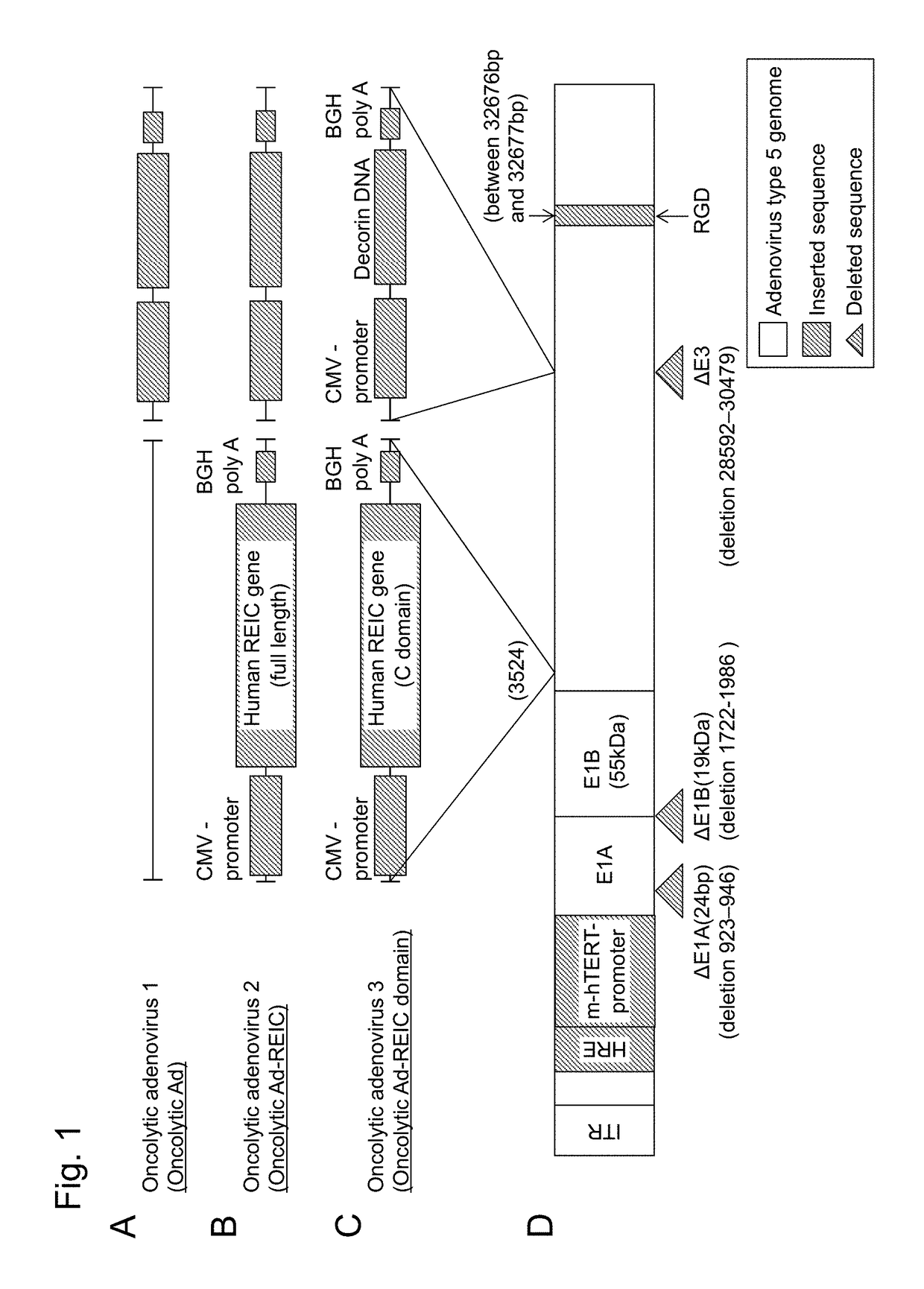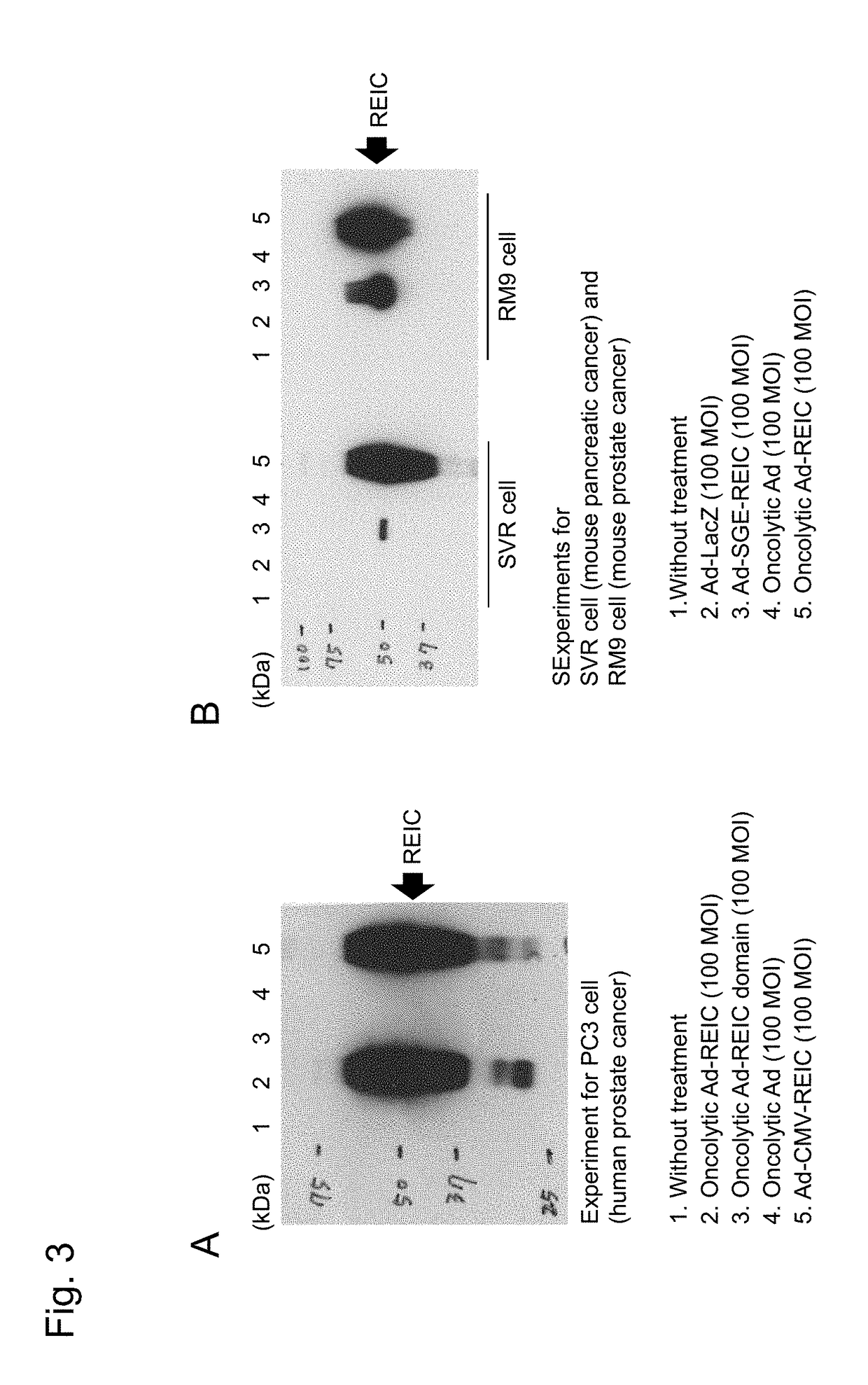Conditionally replicating adenovirus to express REIC gene
a technology of reic and adenovirus, which is applied in the field of highly replicating adenovirus, can solve the problems of limiting the therapeutic effect of telomelysin, limiting the therapeutic effect of t-vec, and limited effects, and achieves strong anticancer effect and strong therapeutic effect against cancer
- Summary
- Abstract
- Description
- Claims
- Application Information
AI Technical Summary
Benefits of technology
Problems solved by technology
Method used
Image
Examples
example 1
Production of Oncolytic Adenoviruses (Oncolytic Adenovirus: Oncolytic Ad)
[0078]To produce oncolytic adenoviruses to express REIC or REIC C domain (REIC-C) and decorin (DCN) in the E1 region and E3 region, respectively, a pCA14 Ad E1 shuttle vector to express the REIC or REIC C was first produced. The REIC or REIC C gene was cut out of pShuttole / REIC or REIC-C with NheI-blunt-HindIII, and was subcloned into the pCA14 Ad E1 shuttle vector digested in advance with XbaI-blunt-HindIII. The pCA14 / REIC and pCA14 / REIC-C vectors were digested with BglII, and then were each cloned into a pΔE1sp1B-HmT-Rd19 shuttle vector (Kim E et al., Hum Gene Ther 2003; 14:1415-1428; Kim J H et al., J Natl Cancer Inst 2006; 98:1482-1493) whose CMV-REIC-polA and AMV-REIC-C-polA expression cassettes had been digested in advance with BglII to obtain pΔE1sp1B-HmT-Rd19 / REIC and pΔE1sp1B-HmT-Rd19 / REIC-C adenovirus E1 shuttle vectors. A pSP72-E3 / DCN (I-K Choi et al., Gene Therapy 2010; 17:190-201.) E3 shuttle vecto...
example 2
Expression of REIC Protein in Various Cells by Addition of Oncolytic Ad, Oncolytic Ad-REIC, and Oncolytic Ad-REIC Domain
Method
[0081]To measure expression of REIC protein after treatment with the Ad-REIC, cells were seeded in a flat-bottomed 6-well plate and incubated for 24 hours. The cells were infected with an adenovirus at an MOI (multiplicity of infection) as set forth in Figures in a complete medium (300 μL) for 1 hour, and washed with PBS (phosphate buffered saline) twice, and lysed with a lysis buffer (50 mM HEPES, pH 7.4, 250 mM NaCl, 1 mM EDTA, 1% NP-40, 1 mM DTT, 1 mM PMSF, 5 μg / mL leupeptin, 5 μg / mL aprotinin, 2 mM Na3VO4, 1 mM NaF, 10 mM β-GP) to extract REIC protein.
[0082]After centrifugation, the supernatant was diluted with an identical volume of 4×SDS sample buffer, and heated at 95° C. for 5 minutes. A sample (protein: 5 μg) was separated on a 10% SDS-PAGE gel, and electrophoretically transferred onto a polyvinylidene fluoride (PVDF) membrane. The blot transferred w...
example 3
Investigation of Cell Death-Inducing Rate in Various Cells by Addition of Oncolytic Ad and Oncolytic Ad-REIC
Method
[0085]To investigate the cell-killing rate after treatment with the Ad-REIC, cells were seeded in a flat-bottomed 6-well plate and incubated for 24 hours. The cells were treated with an adenovirus at an MOI (multiplicity of infection) as set forth in Figures in a complete medium (300 μL) for 1 hour, and 1700 μL of a fresh medium was added thereto. On the days as set forth in Figures, the dead cell ratio (%) was measured in microscopic observation for 5 views. In FIGS. 4 to 6, data are represented as average±standard deviation. For the statistical significance test, analysis of variance or a Mann-Whitney U test was performed. p<0.05 was determined to have a significant difference.
Results
[0086]FIG. 4 shows the cell death-inducing rate in various cells by addition of the oncolytic Ad and oncolytic Ad-REIC. As shown in FIG. 4, the oncolytic Ad-REIC induced cell death at a si...
PUM
| Property | Measurement | Unit |
|---|---|---|
| volume | aaaaa | aaaaa |
| length | aaaaa | aaaaa |
| length REIC | aaaaa | aaaaa |
Abstract
Description
Claims
Application Information
 Login to View More
Login to View More - R&D
- Intellectual Property
- Life Sciences
- Materials
- Tech Scout
- Unparalleled Data Quality
- Higher Quality Content
- 60% Fewer Hallucinations
Browse by: Latest US Patents, China's latest patents, Technical Efficacy Thesaurus, Application Domain, Technology Topic, Popular Technical Reports.
© 2025 PatSnap. All rights reserved.Legal|Privacy policy|Modern Slavery Act Transparency Statement|Sitemap|About US| Contact US: help@patsnap.com



